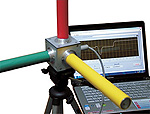Laboratory of Radiospectroscopy and Spintronics
Laboratory Staff
Selected Publications
Equipment
The Laboratory was organized in 2008 and, since then, has been led by Dr. Nikita V. Volkov, the KIP’s Director. The Lab’s staff comprises 20 researches and engineers, with three doctors and seven candidates of physics and mathematics included.
Research Focus
- Nuclear magnetic and electron magnetic resonance spectroscopy of a wide variety of materials.
- Spin dynamics and quantum calculations.
- Search for new magnetic materials and investigation of their physical properties.
- Spin-polarized electron transport in low-dimensional magnetic and hybrid structures.
The Lab’s researches study spin-dependent electron transport in magnetic tunnel and hybrid structures. In the planar investigation geometry we found the effect of current channel switching between structural layers and the magnetoresistive effect driven by a newly discovered mechanism.
We investigate the phenomena occurring in cooperative systems of magnetic tunnel contacts as a result of the interrelation between the spin-polarized current and spin dynamics in the contacts.
We search for and study novel materials for spintronics, being especially interested in manganese oxides with mixed valence of manganese ions Mn3+ and Mn4+.
Among our research goals is determination of the structure and dynamics of partially disordered crystals. Under investigations are the substances with the disordering of different origin, including structurally incommensurate crystals, ionic conductors, relaxor ferroelectrics, and solid solutions.
Our staff develops the dynamic theory of nuclear magnetic moments of crystals and studies the multipulse NMR methods for transforming quantum information to be applied in quantum computing.
The research area that has been recently elaborated is the study of magnetoelectric multiferroics. The complex investigations of magnetic, magnetoelectrical, magnetoelastic and magnetooptical characteristics of the grown single crystals are aimed at clarifying the micromechanisms and conditions of enhancing the novel magnetic and magnetoelectric phenomena under investigation.
Advanced developments
ESR magnetometers
 These are compact high magnetometers for vector measurements of weak magnetic fields, in particular, the Earth’s geomagnetic field. The attained threshold sensitivity of the devices is 1 nT, which is still not the limit. Data accumulation is fully automated; the software employed synchronizes measurement results by absolute time and coordinate. Our magnetometers can be useful in geology, geophysics, archaeology, space exploration.
These are compact high magnetometers for vector measurements of weak magnetic fields, in particular, the Earth’s geomagnetic field. The attained threshold sensitivity of the devices is 1 nT, which is still not the limit. Data accumulation is fully automated; the software employed synchronizes measurement results by absolute time and coordinate. Our magnetometers can be useful in geology, geophysics, archaeology, space exploration.
Group grows of single crystals

Our team has developed the technique for flux group growing of high-quality single crystals that are used in microwave engineering, magnetooptics and as research objects. In particular, we grew single crystals of yttrium iron garnet with the nearly maximum attainable Q factor and optical transmittance. The crystals are used in Faraday IR insulators and gyromagnetic microwave devices.

